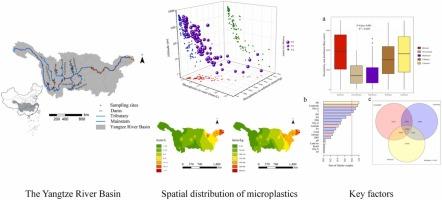Occurrence and characteristics of microplastics across the watershed of the world’s third-largest river
IF 12.2
1区 环境科学与生态学
Q1 ENGINEERING, ENVIRONMENTAL
引用次数: 0
Abstract
While rivers as primary conduits for land-based plastic particles transferring to their "ultimate" destination, the ocean, have garnered increasing attention, research on microplastic pollution at the scale of whole large river basins remains limited. Here we conducted a large-scale investigation of microplastic contamination in water and sediment of the world’s third-largest river, the Yangtze River. We found concentrations of microplastics in water and sediment to be 5.13 items/L and 113.9 items/kg (dry weight), respectively. Moreover, microplastic pollution levels exhibited a clear decreasing trend from upstream to downstream. The detected microplastics were predominantly transparent in color, with fibrous shapes predominating, sizes mainly concentrated below 1 mm and composed primarily of PP and PE polymers. Our analysis results indicated that compared to geographical and water quality parameters, anthropogenic factors primarily determined the spatial distribution pattern of microplastics. Moreover, the microplastic abundance in sediment upstream of the dam was significantly higher than that in the downstream sediment, while the trend of microplastic concentrations in water was opposite. Therefore, more effort is needed to monitor microplastic contamination and their ecological environmental effects of sediment before dams in future research.

世界第三大河流域微塑料的出现和特征
河流作为陆地塑料微粒向其 "最终 "目的地--海洋转移的主要通道,已引起越来越多的关注,但在整个大型流域范围内对微塑料污染的研究仍然有限。在这里,我们对世界第三大河流长江的水和沉积物中的微塑料污染进行了大规模调查。我们发现水和沉积物中的微塑料浓度分别为 5.13 微克/升和 113.9 微克/千克(干重)。此外,微塑料污染水平从上游到下游呈明显下降趋势。检测到的微塑料主要呈透明色,形状以纤维状为主,尺寸主要集中在 1 毫米以下,主要成分为聚丙烯(PP)和聚乙烯(PE)聚合物。分析结果表明,与地理和水质参数相比,人为因素是决定微塑料空间分布模式的主要因素。此外,大坝上游沉积物中的微塑料丰度明显高于下游沉积物,而水中微塑料浓度的变化趋势则相反。因此,在今后的研究中需要加大力度监测坝前沉积物的微塑料污染及其生态环境效应。
本文章由计算机程序翻译,如有差异,请以英文原文为准。
求助全文
约1分钟内获得全文
求助全文
来源期刊

Journal of Hazardous Materials
工程技术-工程:环境
CiteScore
25.40
自引率
5.90%
发文量
3059
审稿时长
58 days
期刊介绍:
The Journal of Hazardous Materials serves as a global platform for promoting cutting-edge research in the field of Environmental Science and Engineering. Our publication features a wide range of articles, including full-length research papers, review articles, and perspectives, with the aim of enhancing our understanding of the dangers and risks associated with various materials concerning public health and the environment. It is important to note that the term "environmental contaminants" refers specifically to substances that pose hazardous effects through contamination, while excluding those that do not have such impacts on the environment or human health. Moreover, we emphasize the distinction between wastes and hazardous materials in order to provide further clarity on the scope of the journal. We have a keen interest in exploring specific compounds and microbial agents that have adverse effects on the environment.
 求助内容:
求助内容: 应助结果提醒方式:
应助结果提醒方式:


